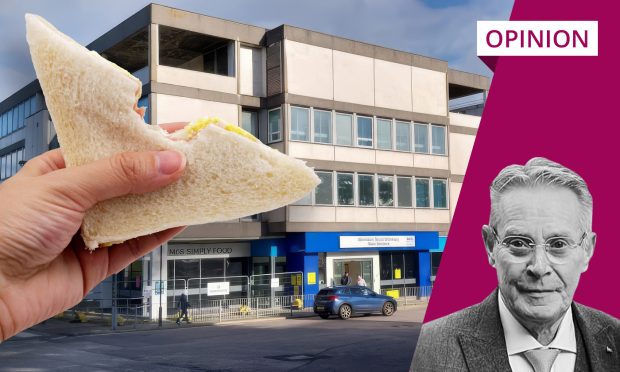My wife and I have been arguing about doughnuts lately.
I ask you, as if we haven’t got better things to do.
But it’s all connected with the law of supply and demand.
Our doughnut dilemma is not that different to NHS Grampian’s sandwich crisis.
They’ve been forced to spread them more thinly to save cash.
Not literally, that is; I think the fillings are just the same.
It’s about wasteful and unnecessary amounts of food for patients.
Health bosses were alarmed that orders for meals and sandwiches from hospital wards were often higher than the actual number of patients.
Efforts to cut food waste
Now sandwich orders might be blocked altogether in certain circumstances to cut food waste by a staggering £1 million.
I think we’d all agree the price tag on such needless waste at the public’s expense is hard to swallow.
Yes, I admit to buying more doughnuts than I need for some time now.
But I blame suppliers: wherever I look, I can only buy them in packs of four or five when I could make do with one.
Don’t tell me to buy one of those individual Krispy Kreme things instead; give me an old-fashioned doughnut.
I love them, but my wife doesn’t; so the best I can do is demolish two before throwing the rest away the next day as they go off.
At this rate of wastage I should be working for the NHS.
I don’t wish to scoff at hospital food as it’s a soft target; in fact, scoffing it is actually a problem for many patients who turn their noses up when it arrives at their bedsides.
But have you thought about the level of difficulty in delivering food on this scale every day?
NHS facing daily pressures
The fact that bean counters are looking closely at its efficiency shows the state the NHS is in – like a wartime bomber jettisoning stuff overboard to stay in the air.
I’ve had plenty of time to study the comings and goings of hospital food trolleys, too.
A couple of spells in orthopaedic surgery with my wife in Aberdeen and months of going in and out of geriatric wards elsewhere in the UK with my ailing mother-in-law.
These experiences seemed to confirm that there was little difference in the challenges facing the NHS on either side of the border.
There was something about the food in both places which defied the laws of physics.
At first I thought it was an optical illusion, but it looked as though more discarded food was going out of the wards to rubbish dumps in bin bags than the amount which had been served in the first place.
How could this be?
Yes, a lot of it wasn’t being eaten by patients, but it’s now dawning on me – after the sandwich revelations – that they might have been ordering far more food than they needed all along.
I don’t know if it was something to do with the morphine they were giving her for the pain, but my wife couldn’t face a sandwich they brought to her which was on the stale side and curling up.
Nursing staff were lovely and their hearts were in the right place, but most of the food was being trucked in from some NHS kitchen elsewhere.
So I was despatched quickly to bring in sandwiches from M&S or Tesco from then on.
Radical alternatives could be impractical
Was all this a sign of things to come?
Will families have to bring their own food in for patients to spare the NHS the trouble?
Those who can afford it would probably prefer that anyway.
But like so many reforms suggested for the NHS, the knock-on effects of radical alternatives make them impractical and even more expensive than trying to improve the existing service.
And is all this window dressing when compared to the one thing blighting communities across the north and north-east: horrific waiting lists, in which some patients are dying – literally – to see the end of them.
Does a leaner and fitter NHS bureaucracy mean thousands of people in the Highlands and Grampian on endless waiting lists will be treated quicker?
These issues seem mutually exclusive as one does not necessarily trigger a positive effect on the other.
Funnily enough, the NHS actually solved my doughnut problem.
I discovered you could buy a single doughnut in the M&S outlet at Aberdeen Royal Infirmary (I suppose that’s because they are aimed at individual staff or patients lying in bed).
But I can hardly drive there and selfishly occupy a parking space intended for patients – just to buy one doughnut.
I did notice “supply and demand” again: a single doughnut here cost the same as four in a pack at other M&S stores.
Maybe M&S should try running hospitals and health bosses look after doughnuts.
David Knight is the long-serving former deputy editor of The Press and Journal




Conversation